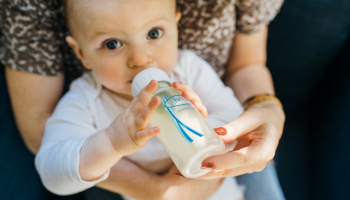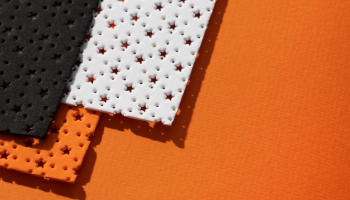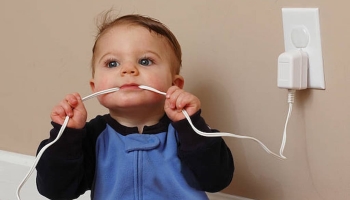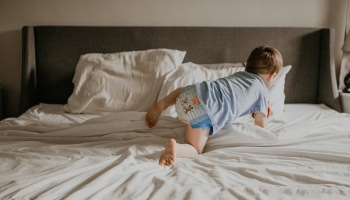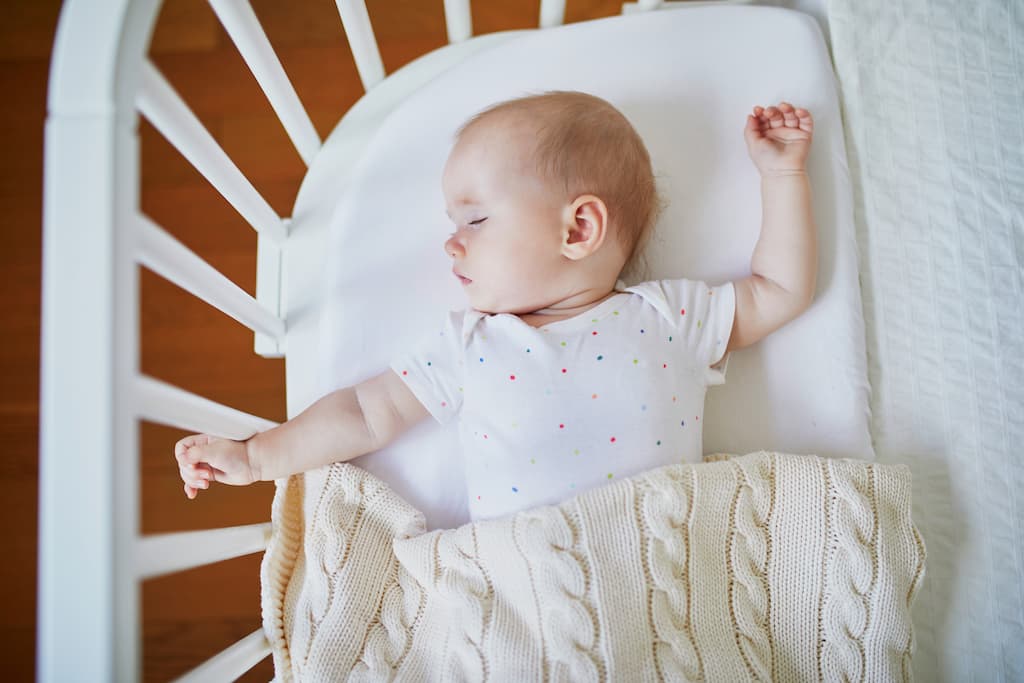
Bassinets are a popular choice for parents of newborn babies due to their convenience and portability. One of the most critical aspects to consider when you decide to buy a bassinet is the bassinet weight limit. Newborn babies grow quickly both in terms of weight and height, so understanding this limit is crucial.
Though the bassinet weight limit can vary based on the type of bassinet and the manufacturer’s recommendations, it’s often determined by a combination of the baby’s weight and height. A few months of age can make a significant difference in the weight of your baby, hence why many parents keep a close eye on their baby’s weight progression to ensure they remain safely inside the bassinet.
Key Takeaways
- Bassinets have weight limits that must be followed to ensure the safety of the baby.
- The weight limit is based on the size and weight of the baby and the structural integrity of the bassinet.
- When choosing a bassinet, parents should consider the weight limit and other safety features, and transition their baby to a crib once they have outgrown the bassinet.
Types of Bassinets and Their Weight Limits
When it comes to bassinets, there are several types to choose from, each with its own weight limit. Here are some of the most popular types of bassinets and their weight limits:
Portable Bassinets
These bassinets are designed to be lightweight and easy to move from room to room. Most portable bassinets have a weight limit of around 15-20 pounds.
Rocking Bassinets
These bassinets have a gentle rocking motion that can help soothe a baby to sleep. Most rocking bassinets have a weight limit of around 15-20 pounds.
Bedside Bassinets
These bassinets are designed to attach to the side of an adult bed, allowing parents to keep their baby close by. Most bedside bassinets have a weight limit of around 25 pounds.
Traditional Bassinets
These bassinets have a classic look and feel, and are often made from wood or wicker. Most traditional bassinets have a weight limit of around 15-20 pounds.
Smart Bassinets
These bassinets come with features like built-in sound machines, night lights, and even the ability to detect a baby’s cries and automatically soothe them back to sleep. The weight limit for smart bassinets varies depending on the model.
Pack and Play
These portable playards often come with a bassinet attachment for newborns. The weight limit for the bassinet attachment is typically around 15 pounds.
Travel Bassinets
These compact bassinets are designed for families on the go. Most travel bassinets have a weight limit of around 15-20 pounds.
It’s important to always check the weight limit of a bassinet before using it with your baby. Exceeding the weight limit can be dangerous and increase the risk of injury.
Bassinet Weight Limit List
A cutting-edge bassinet integrating smart technology, the SNOO offers a higher weight threshold, accommodating growing babies with ease and ensuring added longevity for parents seeking a lasting solution.
Weight Limit: 25 lbs (11.3 kg)
With a swivel design that allows for convenient positioning, this bassinet is adept for average-weight infants. Its unique construction brings the baby closer to the bedside, merging functionality with comfort.
Weight Limit: 20 lbs (9 kg)
Marrying modern design with technical innovation, the 4moms bassinet offers motion patterns to soothe babies. With a generous weight limit, it serves parents from the newborn phase through substantial growth stages.
Weight Limit: 25 lbs (11.3 kg)
A lightweight and compact cradle, BABYBJÖRN is designed for easy mobility. While it caters primarily to newborns and younger infants, its minimalist aesthetics and construction ensure it’s a stylish addition to any room.
Weight Limit: 17 lbs (7.7 kg)
Ideal for parents who prefer co-sleeping arrangements, this bassinet provides safety and comfort. Designed for moderate weights, it remains a practical choice throughout a baby’s early months.
Weight Limit: 20 lbs (9 kg)
A versatile 2-in-1 design allows this bassinet to function both as a standalone unit and as a bedside sleeper. It’s tailored for infants approaching the upper weight limits of typical bassinets.
Weight Limit: 24.8 lbs (11.2 kg)
AMKE’s multi-functional design offers parents a comprehensive solution that evolves with their child’s needs. From bassinet to bedside sleeper, its moderate weight capacity ensures durability and longevity.
Weight Limit: 20 lbs (9 kg)
UPPABaby’s sleek design doesn’t compromise on functionality. Designed for the average infant, it combines aesthetic appeal with the reassurance of a sturdy build.
Weight Limit: 20 lbs (9 kg)
RONBEI presents a bassinet tailored for both standalone and bedside usage. It addresses the needs of slightly heavier infants, ensuring both safety and convenience up to its weight threshold.
Weight Limit: 24.8 lbs (11.2 kg)
No products found.
ANGELBLISS offers a durable and elegant design. Suitable for infants up to its weight limit, it promises both safety and aesthetic appeal for modern parents.
Weight Limit: 20 lbs (9 kg)
True to its name, this co-sleeper emphasizes accessibility for breastfeeding mothers. With a slightly above-average weight capacity, it’s a choice that supports a longer duration of use.
Weight Limit: 23 lbs (10.4 kg)
Combining wood elements with a modern design, this co-sleeper stands out in aesthetics. Designed for co-sleeping and breastfeeding, its weight limit caters to most infants in their early months.
Weight Limit: 20 lbs (9 kg)
Portability meets durability in this Dream On Me bassinet. Suitable for travel, it also caters to infants weighing up to its upper limit, making it a versatile choice for on-the-go families.
Weight Limit: 25 lbs (11.3 kg)
With a focus on mobility, the DaVinci Archie is perfect for families that move frequently. It offers a comfortable environment for lighter infants, ensuring they remain snug during transit.
Weight Limit: 17.5 lbs (8 kg)
Designed for close-by night-time convenience, this bassinet ensures your baby is at arm’s length. Though it caters to lighter babies, its purpose is to provide quick access and peace of mind during nighttime hours.
Weight Limit: 15 lbs (6.8 kg)
Safety Considerations for Bassinet Use
When it comes to using a bassinet for your newborn, safety should always be the top priority. Here are some important safety considerations to keep in mind:
Weight Limit
One of the most important safety considerations for bassinet use is the weight limit. It is crucial to follow the manufacturer’s weight limit guidelines to prevent the bassinet from collapsing or tipping over. Parents should also keep in mind that as babies grow and gain weight, they may outgrow the bassinet before they reach the weight limit.
Safe Sleep Guidelines
Bassinet use should always follow safe sleep guidelines to reduce the risk of Sudden Infant Death Syndrome (SIDS). This includes placing the baby on their back to sleep, using a firm and flat sleep surface, and avoiding soft bedding, such as blankets, pillows, and bumper pads.
Fitted Sheet
Using a fitted sheet that fits snugly around the bassinet mattress is important to prevent suffocation hazards. Loose bedding or sheets that do not fit properly can pose a risk to the baby.
Safety Standards
When choosing a bassinet, parents should look for models that meet federal safety standards set by the Consumer Product Safety Commission (CPSC) and are certified by the Juvenile Products Manufacturers Association (JPMA). This ensures that the bassinet has been tested for safety and meets strict guidelines.
Safe Space
Parents should ensure that the bassinet is placed in a safe space, away from hazards such as cords, curtains, and other objects that could pose a risk to the baby. Additionally, the bassinet should be placed on a flat and stable surface to prevent tipping.
Overall, following these safety considerations can help ensure a safe and comfortable sleep environment for your newborn in their bassinet.
Frequently Asked Questions
What is the recommended weight limit for a bassinet?
The recommended weight limit for a bassinet varies depending on the brand and model. Generally, most bassinets have a weight limit of around 15-20 pounds, which is suitable for infants up to around 3-4 months old. It’s important to always follow the manufacturer’s guidelines and not exceed the recommended weight limit.
Are there any safety concerns when using a bassinet with a weight limit?
Yes, there are safety concerns when using a bassinet with a weight limit. If the weight limit is exceeded, the bassinet can become unstable and increase the risk of injury or suffocation to the baby. It’s important to always follow the manufacturer’s guidelines and not exceed the recommended weight limit.
Which bassinet brands offer models with higher weight limits?
Some bassinet brands offer models with higher weight limits than the standard 15-20 pounds. For example, the Halo Bassinest Swivel Sleeper has a weight limit of 30 pounds, while the Graco Dream Suite Bassinet has a weight limit of 20 pounds. It’s important to research and compare different brands and models before making a purchase to ensure that the weight limit meets your needs.
At what age should I transition my baby from a bassinet to a crib?
It’s generally recommended to transition your baby from a bassinet to a crib once they reach around 4-6 months old or when they start to show signs of rolling over or pushing up on their hands and knees. However, every baby is different and it’s important to monitor your baby’s development and adjust accordingly. Always follow the manufacturer’s guidelines and recommendations for transitioning to a crib.
Last update on 2025-05-13 / Affiliate links / Images from Amazon Product Advertising API


















